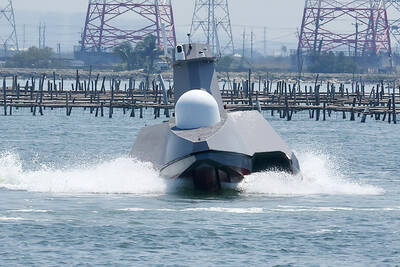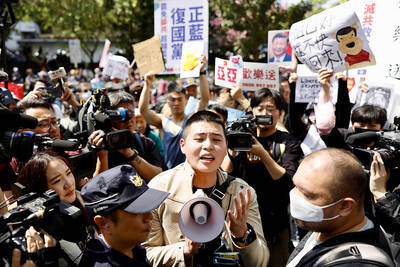Relaxing the restrictions on Taiwanese wafer and plate foundries that move to China could cause disastrous damage to the economy, because it is not only the most profitable industry, but also at the core of the country’s high-tech industry, former government officials and academics warned yesterday.
The warning came at a conference organized by Taiwan Thinktank in response to the policy change announced by the Ministry of Economic Affairs in September that wafer and plate fabrication industries would be allowed to move to China.
The plans are already in the discussion stage and the conclusions will be announced before the end of the year, the ministry said.
“Design and fabrication of 12-inch wafers and plates are the powerhouses behind Taiwan’s economy — the annual profits of the entire integrated chip [IC] industry in the country is about NT$1.2 trillion [US$37 billion], and wafer and faceplate production alone accounts for one-third of it,” former minister of economic affairs Ho Mei-yueh (何美玥) told the conference. “Once such powerhouses are gone, what do we have to fill such a big hole?”
Ho said that wafer and plate foundries were able to create such tremendous profits because the industry is not only about fabrication.
“When a foundry receives an order, it goes out to find a local IC design firm to design the product, buys raw materials locally and tests the product locally,” she said. “When the foundries are gone, it means all those related industries will have to go with them.”
“Taiwan is the second-largest wafer producer in the world after the US, with a global market share of 69 percent, while the Chinese market only accounts for 19 percent. Why not go somewhere else if ‘close to the market’ is such a big factor?” she said. “Wafer foundries in this country get most of their orders from the US and they ship the products back to the US. I don’t see why we cannot follow the same procedures with the Chinese market, especially when we’re geographically so close to each other.”
Business consultant Chien Yao-tang (簡耀堂) said the government may have overestimated the importance of the Chinese market.
“If you remember, in 2000 when Semiconductor Manufacturing International Corp [SMIC] was founded in China, many people despaired, saying if the government didn’t lift the ban on wafer manufacturers moving to China, Taiwanese manufacturers would not be able to get a share of the Chinese market and would be left behind in the global market,” Chien said. “Ten years have passed, the Chinese IC market has been growing, but SMIC has not made a profit, except for one year, even with all the support it receives from the Chinese government.”
Former Executive Yuan adviser Hsiao Chiu-teh (蕭秋德), on the other hand, said he suspected that the government knew nothing about the industry.
“They think the semiconductor industry is like any other low-threshold, labor-intensive industry, like making PCs or umbrellas, that can easily be moved to another country,” Hsiao said. “In fact, the semiconductor industry has highly sensitive technologies at its core that are kept top secret by countries able to manufacture the products.”

ENDEAVOR MANTA: The ship is programmed to automatically return to its designated home port and would self-destruct if seized by another party The Endeavor Manta, Taiwan’s first military-specification uncrewed surface vehicle (USV) tailor-made to operate in the Taiwan Strait in a bid to bolster the nation’s asymmetric combat capabilities made its first appearance at Kaohsiung’s Singda Harbor yesterday. Taking inspiration from Ukraine’s navy, which is using USVs to force Russia’s Black Sea fleet to take shelter within its own ports, CSBC Taiwan (台灣國際造船) established a research and development unit on USVs last year, CSBC chairman Huang Cheng-hung (黃正弘) said. With the exception of the satellite guidance system and the outboard motors — which were purchased from foreign companies that were not affiliated with Chinese-funded

PERMIT REVOKED: The influencer at a news conference said the National Immigration Agency was infringing on human rights and persecuting Chinese spouses Chinese influencer “Yaya in Taiwan” (亞亞在台灣) yesterday evening voluntarily left Taiwan, despite saying yesterday morning that she had “no intention” of leaving after her residence permit was revoked over her comments on Taiwan being “unified” with China by military force. The Ministry of the Interior yesterday had said that it could forcibly deport the influencer at midnight, but was considering taking a more flexible approach and beginning procedures this morning. The influencer, whose given name is Liu Zhenya (劉振亞), departed on a 8:45pm flight from Taipei International Airport (Songshan airport) to Fuzhou, China. Liu held a news conference at the airport at 7pm,

AIR SUPPORT: The Ministry of National Defense thanked the US for the delivery, adding that it was an indicator of the White House’s commitment to the Taiwan Relations Act Deputy Minister of National Defense Po Horng-huei (柏鴻輝) and Representative to the US Alexander Yui on Friday attended a delivery ceremony for the first of Taiwan’s long-awaited 66 F-16C/D Block 70 jets at a Lockheed Martin Corp factory in Greenville, South Carolina. “We are so proud to be the global home of the F-16 and to support Taiwan’s air defense capabilities,” US Representative William Timmons wrote on X, alongside a photograph of Taiwanese and US officials at the event. The F-16C/D Block 70 jets Taiwan ordered have the same capabilities as aircraft that had been upgraded to F-16Vs. The batch of Lockheed Martin

GRIDLOCK: The National Fire Agency’s Special Search and Rescue team is on standby to travel to the countries to help out with the rescue effort A powerful earthquake rocked Myanmar and neighboring Thailand yesterday, killing at least three people in Bangkok and burying dozens when a high-rise building under construction collapsed. Footage shared on social media from Myanmar’s second-largest city showed widespread destruction, raising fears that many were trapped under the rubble or killed. The magnitude 7.7 earthquake, with an epicenter near Mandalay in Myanmar, struck at midday and was followed by a strong magnitude 6.4 aftershock. The extent of death, injury and destruction — especially in Myanmar, which is embroiled in a civil war and where information is tightly controlled at the best of times —